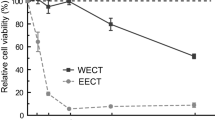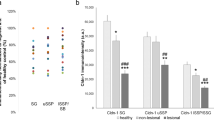Abstract
The stratified squamous epithelium has a multilayer structure formed by the differentiation of the keratinized epithelium, which covers the skin and oral mucosa. The epithelium plays a central role in regulating the interactions between the immune system and pathogens. The tight junction (TJ) barrier, which is composed of adhesion molecules called claudins (CLDN), is critical for the homeostasis of the skin and oral mucosa. Furthermore, the crucial roles of vitamin D3 (VD3) in the pathogeneses of skin and oral mucosal disease have been suggested. The aim of this in vitro study was to observe the correlations between the integrity of the keratinocyte population and the expression levels of CLDN1 and CLDN4 in gingival epithelial cells, stimulated with VD3. CLDN 1 and 4 expression levels were down and upregulated, respectively, in the cells stimulated with VD3. Additionally, transepithelial electrical resistance (TEER) levels were increased in the stimulated cells when compared to the controls. These findings indicate that CLDN 4 may play a more important role in the TJ barrier than CLDN 1. Hence, the therapeutic effect of VD3 in skin and oral diseases may be regulated by the increase in the expression of CLDN 4.






Similar content being viewed by others
References
Sandjeu Y, Haftek M (2009) Desmosealin and other components of the epidermal extracellular matrix. J Physiol Pharmacol 60(Suppl 4):23–30
Yoshida C, Takeichi M (1982) Teratocarcinoma cell adhesion: identification of a cell-surface protein involved in calcium-dependent cell aggregation. Cell 28:217–224
Takeichi M (1995) Morphogenetic roles of classic cadherins. Curr Opin Cell Biol 7:619–627
Furuse M, Fujita K, Hiiragi T, Fujimoto K, Tsukita S (1998) Claudin-1 and -2: novel integral membrane proteins localizing at tight junctions with no sequence similarity to occludin. J Cell Biol 141:1539–1550
Ban Y, Dota A, Cooper LJ, Fullwood NJ, Nakamura T, Tsuzuki M, Mochida C, Kinoshita S (2003) Tight junction-related protein expression and distribution in human corneal epithelium. Exp Eye Res 76:663–669
Leyvraz C, Charles RP, Rubera I, Guitard M, Rotman S, Breiden B, Sandhoff K, Hummler E (2005) The epidermal barrier function is dependent on the serine protease CAP1/Prss8. J Cell Biol 170:487–496
Li J, Ananthapanyasut W, Yu AS (2011) Claudins in renal physiology and disease. Pediatr Nephrol 26:2133–2142
Nielsen HL, Nielsen H, Ejlertsen T, Engberg J, Günzel D, Zeitz M, Hering NA, Fromm M, Schulzke JD, Bücker R (2011) Oral and fecal Campylobacter concisus strains perturb barrier function by apoptosis induction in HT-29/B6 intestinal epithelial cells. PLoS ONE 6:e23858
Yamazaki Y, Tokumasu R, Kimura H, Tsukita S (2011) Role of claudin species-specific dynamics in reconstitution and remodeling of the zonula occludens. Mol Biol Cell 22:1495–1504
Tsukita S, Furuse M, Itoh M (2001) Multifunctional strands in tight junctions. Nat Rev Mol Cell Biol 2:285–293
Kiuchi-Saishin Y, Gotoh S, Furuse M, Takasuga A, Tano Y, Tsukita S (2002) Differential expression patterns of claudins, tight junction membrane proteins, in mouse nephron segments. J Am Soc Nephrol 13:875–886
Brandner JM, Kief S, Grund C, Rendl M, Houdek P, Kuhn C, Tschachler E, Franke WW, Moll I (2002) Organization and formation of the tight junction system in human epidermis and cultured keratinocytes. Eur J Cell Biol 81:253–263
Rozlomiy VL, Markov AG (2010) Effect of interleukin-1β on the expression of tight junction proteins in the culture of HaCaT keratinocytes. Bull Exp Biol Med 149:280–283
Li J, Li Q, Geng S (2019) All-trans retinoic acid alters the expression of the tight junction proteins Claudin-1 and -4 and epidermal barrier function-associated genes in the epidermis. Int J Mol Med 43:1789–1805
Yokoyama S, Tachibana K, Nakanishi H, Yamamoto Y, Irie K, Mandai K, Nagafuchi A, Monden M, Takai Y (2001) alpha-catenin-independent recruitment of ZO-1 to nectin-based cell-cell adhesion sites through afadin. Mol Biol Cell 12:1595–1609
Hartsock A, Nelson WJ (2008) Adherens and tight junctions: structure, function and connections to the actin cytoskeleton. Biochim Biophys Acta 1778:660–669
Hämäläinen L, Soini Y, Pasonen-Seppänen S, Siponen M (2019) Alterations in the expression of EMT-related proteins claudin-1, claudin-4 and claudin-7, E-cadherin, TWIST1 and ZEB1 in oral lichen planus. J Oral Pathol Med 48:735–744
Bergqvist C, Ezzedine K (2019) Vitamin D and the skin: what should a dermatologist know? G Ital Dermatol Venereol 154:669–680
Holick MF (2009) Vitamin D status: measurement, interpretation, and clinical application. Ann Epidemiol 19:73–78
Christakos S, Ajibade DV, Dhawan P, Fechner AJ, Mady LJ (2010) Vitamin D: metabolism. Endocrinol Metab Clin North Am 39:243–253
Fathi N, Ahmadian E, Shahi S, Roshangar L, Khan H, Kouhsoltani M, Maleki Dizaj S, Sharifi S (2019) Role of vitamin D and vitamin D receptor (VDR) in oral cancer. Biomed Pharmacother 109:391–401
Martin NG, Rigterink T, Adamji M, Wall CL, Day AS (2019) Single high-dose oral vitamin D3 treatment in New Zealand children with inflammatory bowel disease. Transl Pediatr 8:35–41
Aral K, Alkan BA, Saraymen R, Yay A, Şen A, Önder G (2015) Therapeutic effects of systemic vitamin k2 and vitamin d3 on gingival inflammation and alveolar bone in rats with experimentally induced periodontitis. J Periodontol 86:666–673
Wadhwa B, Relhan V, Goel K, Kochhar AM, Garg VK (2015) Vitamin D and skin diseases: a review. Indian J Dermatol Venereol Leprol 81:344–355
Bijlsma MF, Roelink H (2017) Skin-derived vitamin D(3) protects against basal cell carcinoma. J Invest Dermatol 137:2469–2471
Lebwohl M (2003) Psoriasis. Lancet 361:1197–1204
Kurashige Y, Saitoh M, Nishimura M, Noro D, Kaku T, Igarashi S, Takuma T, Arakawa T, Inoue T, Abiko Y (2008) Profiling of differentially expressed genes in porcine epithelial cells derived from periodontal ligament and gingiva by DNA microarray. Arch Oral Biol 53:437–442
Yoshida K, Uehara O, Kurashige Y, Paudel D, Onishi A, Neopane P, Hiraki D, Morikawa T, Harada F, Takai R, Sato J, Saitoh M, Abiko Y (2021) Direct reprogramming of epithelial cell rests of malassez into mesenchymal-like cells by epigenetic agents. Sci Rep 11:1852
Livak KJ, Schmittgen TD (2001) Analysis of relative gene expression data using real-time quantitative PCR and the 2(-Delta Delta C(T)) method. Methods 25:402–408
Zhang XM, Huang Y, Zhang K, Qu LH, Cong X, Su JZ, Wu LL, Yu GY, Zhang Y (2018) Expression patterns of tight junction proteins in porcine major salivary glands: a comparison study with human and murine glands. J Anat 233:167–176
Yuan FN, Valiyaparambil J, Woods MC, Tran H, Pant R, Adams JS, Mallya SM (2014) Vitamin D signaling regulates oral keratinocyte proliferation in vitro and in vivo. Int J Oncol 44:1625–1633
Bikle DD (2010) Vitamin D and the skin. J Bone Miner Metab 28:117–130
Kommagani R, Whitlatch A, Leonard MK, Kadakia MP (2010) p73 is essential for vitamin D-mediated osteoblastic differentiation. Cell Death Differ 17:398–407
Jugert FK, Roos TC, Notzon I, Merk HF (1998) Vitamin D3 and its synthetic analogue secocholestra-trien-1,2, 24-triol influence the metabolism and the isomerization of retinoic acid in human keratinocytes. Skin Pharmacol Appl Skin Physiol 11:161–165
Tone T, Eto H, Katsuoka K, Nishioka K, Nishiyama S (1991) Suppression of gamma-interferon induced HLA-DR antigen expression on normal and transformed keratinocytes by 1,25 (OH)2 vitamin D3. Nihon Hifuka Gakkai Zasshi 101:519–525
Yuki T, Hachiya A, Kusaka A, Sriwiriyanont P, Visscher MO, Morita K, Muto M, Miyachi Y, Sugiyama Y, Inoue S (2011) Characterization of tight junctions and their disruption by UVB in human epidermis and cultured keratinocytes. J Invest Dermatol 131:744–752
Hatakeyama S, Yaegashi T, Oikawa Y, Fujiwara H, Mikami T, Takeda Y, Satoh M (2006) Expression pattern of adhesion molecules in junctional epithelium differs from that in other gingival epithelia. J Periodontal Res 41:322–328
Hatakeyama S, Ishida K, Takeda Y (2010) Changes in cell characteristics due to retinoic acid; specifically, a decrease in the expression of claudin-1 and increase in claudin-4 within tight junctions in stratified oral keratinocytes. J Periodontal Res 45:207–215
Wang K, Pascal LE, Li F, Chen W, Dhir R, Balasubramani GK, DeFranco DB, Yoshimura N, He D, Wang Z (2020) Tight junction protein claudin-1 is downregulated by TGF-β1 via MEK signaling in benign prostatic epithelial cells. Prostate 80:1203–1215
Kojima T, Kohno T, Kubo T, Kaneko Y, Kakuki T, Kakiuchi A, Kurose M, Takano KI, Ogasawara N, Obata K, Nomura K, Miyata R, Konno T, Ichimiya S, Himi T (2017) Regulation of claudin-4 via p63 in human epithelial cells. Ann N Y Acad Sci 1405:25–31
Koli K, Keski-Oja J (1993) Vitamin D3 and calcipotriol enhance the secretion of transforming growth factor-beta 1 and -beta 2 in cultured murine keratinocytes. Growth Factors 8:153–163
Chen H, Lu R, Zhang YG, Sun J (2018) Vitamin D receptor deletion leads to the destruction of tight and adherens junctions in lungs. Tissue Barriers 6:1–13
Gorman S, Buckley AG, Ling KM, Berry LJ, Fear VS, Stick SM, Larcombe AN, Kicic A, Hart PH (2017) Vitamin D supplementation of initially vitamin D-deficient mice diminishes lung inflammation with limited effects on pulmonary epithelial integrity. Physiol Rep 5:e13371
Wu J, He C, Bu J, Luo Y, Yang S, Ye C, Yu S, He B, Yin Y, Yang X (2020) Betaine attenuates LPS-induced downregulation of occludin and claudin-1 and restores intestinal barrier function. BMC Vet Res 16:75
Gan H, Wang G, Hao Q, Wang QJ, Tang H (2013) Protein kinase D promotes airway epithelial barrier dysfunction and permeability through down-regulation of claudin-1. J Biol Chem 288:37343–37354
Wu L, Oshima T, Tomita T, Ohda Y, Fukui H, Watari J, Miwa H (2016) Serotonin disrupts esophageal mucosal integrity: an investigation using a stratified squamous epithelial model. J Gastroenterol 51:1040–1049
Author information
Authors and Affiliations
Corresponding author
Additional information
Publisher's Note
Springer Nature remains neutral with regard to jurisdictional claims in published maps and institutional affiliations.
Rights and permissions
About this article
Cite this article
Minowa, E., Kurashige, Y., Islam, S.T. et al. Increased integrity of cell–cell junctions accompanied by increased expression of claudin 4 in keratinocytes stimulated with vitamin D3. Med Mol Morphol 54, 346–355 (2021). https://doi.org/10.1007/s00795-021-00299-1
Received:
Accepted:
Published:
Issue Date:
DOI: https://doi.org/10.1007/s00795-021-00299-1




